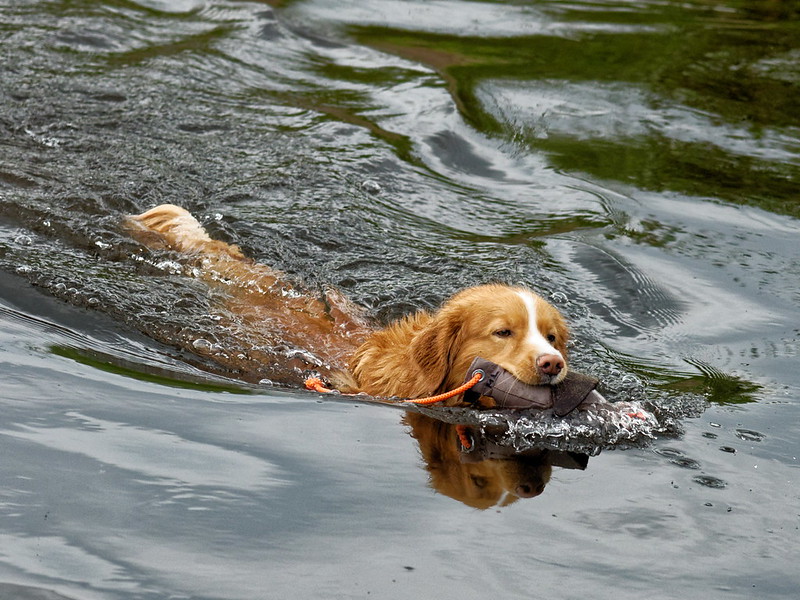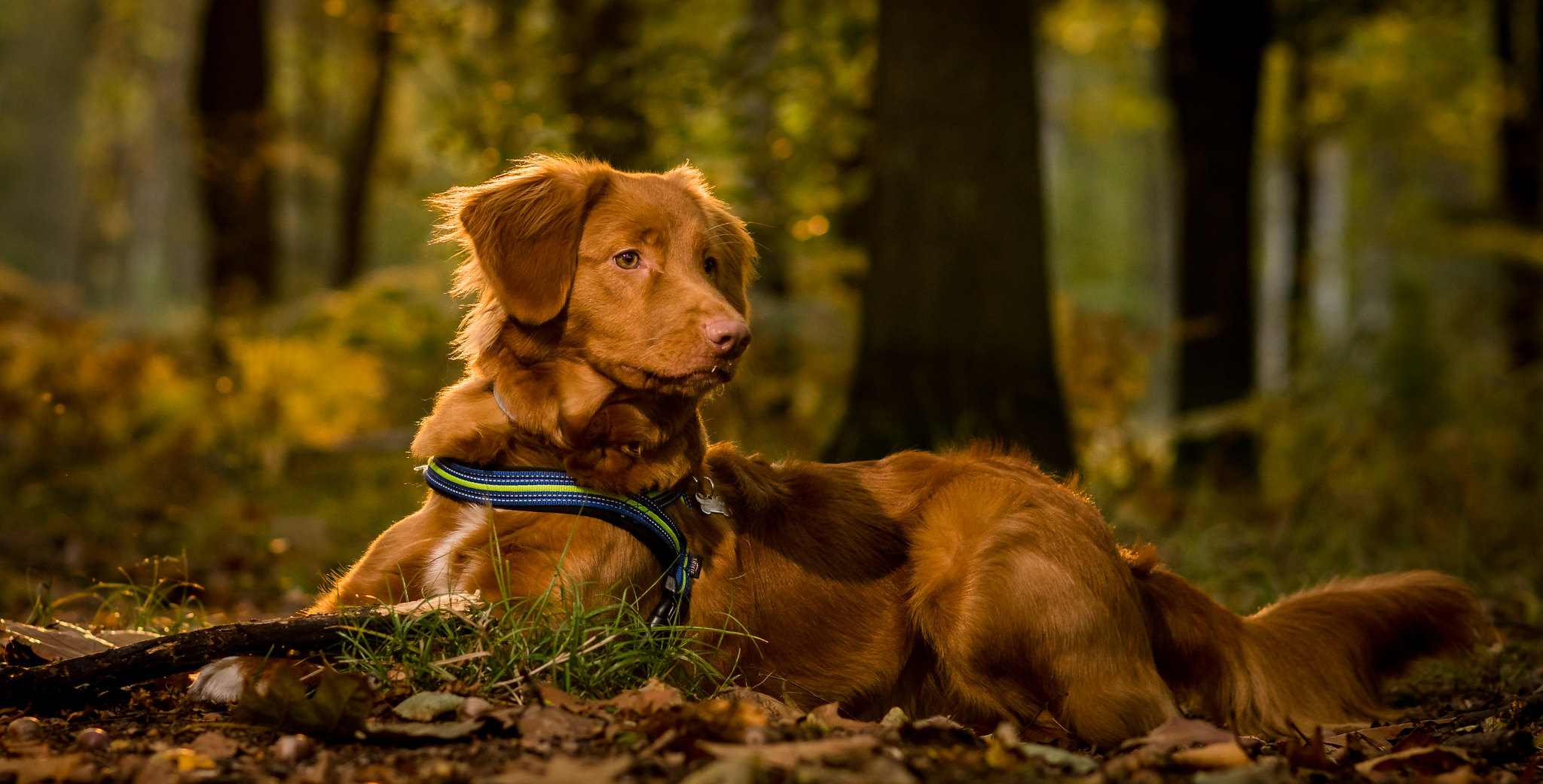The earliest record of color variation in dogs is from 10,000 year old archeological evidence. Now, finally, the intensity of this variation has been explained genetically due to the work of researchers at the University of California-Davis. In this research, the use of genome-wide association was used for specific dogs to determine the number of copies of a copy number variant (CNV), which is a repeating section of the genome, present in their DNA. A genome-wide association study involves rapidly scanning a genome to find areas where there is genetic variation. By using this method, the researchers discovered a genetic region that controls color intensity in a number of dog breeds.
They found that a CNV in the KITLG gene on chromosome 15 controls color intensity in dogs. The higher the number of copies of this CNV, the more intense the color of the dog’s coat.
Pigmentation in dogs can come from the chemicals pheomelanin (yellow) and eumelanin (black). One gene that has been found to control the variation of these pigments in dogs is the KITLG gene. To evaluate the genetic basis for light and dark red phenomelanin, the UC-Davis researchers conducted a genome-wide association study in 35 Nova Scotia Duck Tolling Retrievers. These dogs were classified as light (n=23) or dark (n=13).
Blood and saliva were collected from these dogs through the UC-Davis Veterinary Medical Teaching Hospital. To compare the CNVs in the genetic data from different Nova Scotia Retrievers, the researchers used the PCR method, where DNA is broken down into pieces and and then multiplied to attain a number of copies of a specified portion of the DNA. Next, they performed the genome-wide association study across the KITLG gene and then compared the number of CNVs. The results showed that dark red hair Nova Scotia Retrievers had significantly more CNV copies compared to light red hair Retrievers.

Image from malp007 via Flickr. A Nova Scotia Retriever training with a wooden duck.
These dogs were originally known as the little river duck dog. They have webbed feet and a double coat so they are well adapted to water and so they have been used for waterfowl hunting for two centuries.
These comparisons were repeated in multiple different breeds such as light grey breeds like the Bearded Collies and Old English Shepherds, and also in black breeds like Rottweilers and Black Coated Retrievers. The results showed that there was a correlation between high CNV copy numbers and dog hair color intensity.
This correlation was not found in Poodles, a breed with longer hair. Analysis along the hair shaft showed that Poodles with higher CNV copy numbers had more uniform color intensity and a higher average hair color intensity along the length of their hairs . Poodles with lower CNV copy numbers had less color intensity in the roots of their hairs, more color intensity at the tips, and less overall color intensity. This led to the hypothesis that higher CNV copy numbers lead to a more uniform color intensity and a higher average color intensity.
Prior to these discoveries, the understanding of pigmentation in dogs was that it was controlled through the pigment switching genes MC1R and ASIP. The alteration of MC1R and ASIP leads to the different variations in color. For example, the appearance of solid red/ yellow means that there is a loss of function of MC1R which results in the sole production of pheomelanin.
In this new study, by comparing genetic data, the researchers have demonstrated that the CNV in the KITLG gene is a newly discovered portion of DNA that controls the intensity of eumelanin and pheomelanin intensity in a number of dog breeds with a spectrum of coat colors. However, there are some breeds where this correlation has been found to be inconclusive; namely in Golden Retrievers and Labrador Retrievers, where there is no significance in CNV copy numbers. Due to large scale artificial breeding practices focused on varying coat colors in dogs, it is not a surprise that there are many different regions of DNA that affect pigmentation in dogs. This would explain why the results seen in these two Retriever breeds are inconclusive as there might be a different DNA region that controls their color.
Weich, K., Affolter, V., York, D., Rebhun, R., Grahn, R., Kallenberg, A., and Bannasch, D. 2020. Pigment Intensity in Dogs is Associated with a Copu Number Variant Upstream of KITLG. Genes 11(1): 75.
For more information, go to: https://www.mdpi.com/2073-4425/11/1/75.

Alex
"This title was very eye catching! That is so interesting that such a ..."
Alex
"This is really interesting! The fact that crops and plants are damaged is ..."
Alex
"Well done, this article is great and the information is very captivating! Ethics ..."
Alex
"I was intrigued throughout the whole article! This is such an interesting topic, ..."
Alex
"This is such an interesting article, and very relevant!! Great job at explaining ..."
Grandpa
"Honey You Did a good job I will forward to my eye doctor "
murphymv
"This article is fascinating because it delves into the details of the research ..."
murphymv
"I agree, adding the photo helped solidify the main finding. "
murphymv
"This is a fascinating finding. I hope this innovative approach to improving transplants ..."
Sherzilla
"This is a great article! I would really love to hear how exactly ..."
Sherzilla
"It's disappointment that these treatments were not very effective but hopefully other researchers ..."
Sherzilla
"I agree with your idea that we need to shift our focus to ..."
Sherzilla
"It's amazing to see how such an everyday household product such as ..."
Lauren Kageler
"I will be interested to see what the data looks like from the ..."
Lauren Kageler
"A very interesting article that emphasizes one of the many benefits that the ..."
maricha
"Great post! I had known about the plight of Little Browns, but I ..."
Sherzilla
"I assumed cancer patients were more at risk to the virus but I ..."
Sherzilla
"Great article! It sheds light on a topic that everyone is curious about. ..."
maricha
"This article is full of really important and relevant information! I really liked ..."
maricha
"Definitely a very newsworthy article! Nice job explaining the structure of the virus ..."
maricha
"It's interesting to think that humans aren't only species dealing with the global ..."
murphymv
"This is very interesting and well explained. I am not too familiar with ..."
Lauren Kageler
"Great article! This post is sure to be a useful resource for any ..."
Lauren Kageler
"Definitely seems like an odd pairing at first, but any step forward in ..."
murphymv
"What an interesting article! As you say, height and dementia seem unrelated at ..."
murphymv
"Great article! I learned several new methods of wildlife tracking. This seems like ..."
murphymv
"Very interesting topic! You explained cascade testing and its importance very well. I ..."
Alex
"This article is really interesting! What got me hooked right away was the ..."
Sabrina
"I found this article super interesting! It’s crazy how everyday products can cause ..."
Erin Heeschen
"I love the layout of this article; it's very eyecatching! The advancements of prosthetics ..."
murphymv
"Awesome article! I like the personality in the writing. Flash Graphene not only ..."
murphymv
"Very interesting work! I don't know a whole lot about genetics, but this ..."
Cami Meckley
"I think the idea of using virtual reality technology to better help prepare ..."
Erin Heeschen
"I wonder if there's a connection between tourist season and wildfires in the ..."
Ralph berezan
"Not bad Good work "
Michelle
"This sounds like it would be a great tool for medical students! ..."